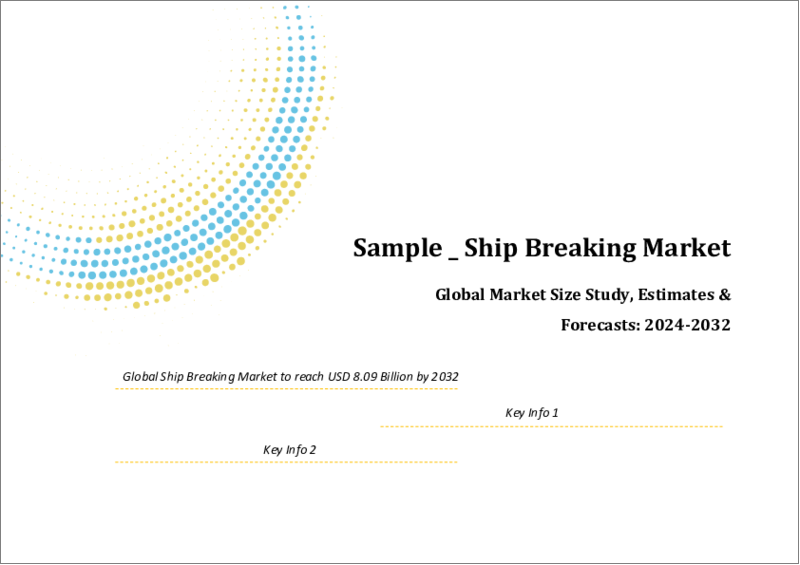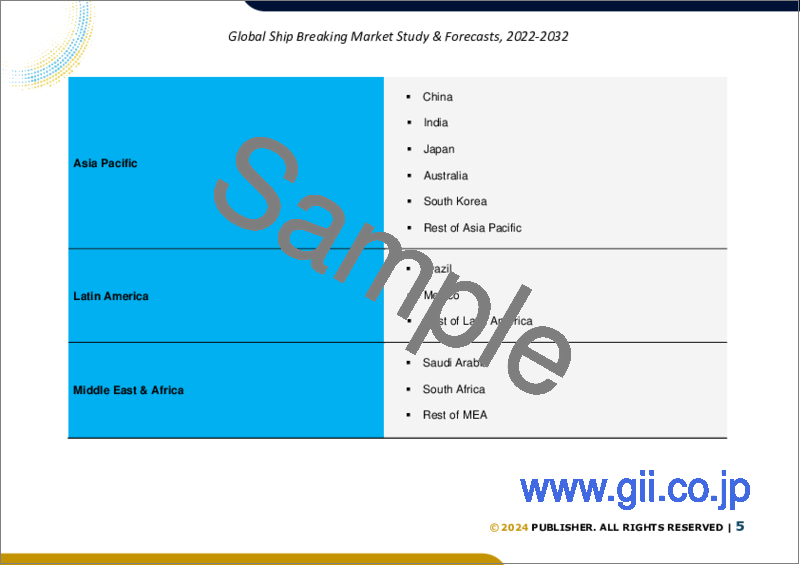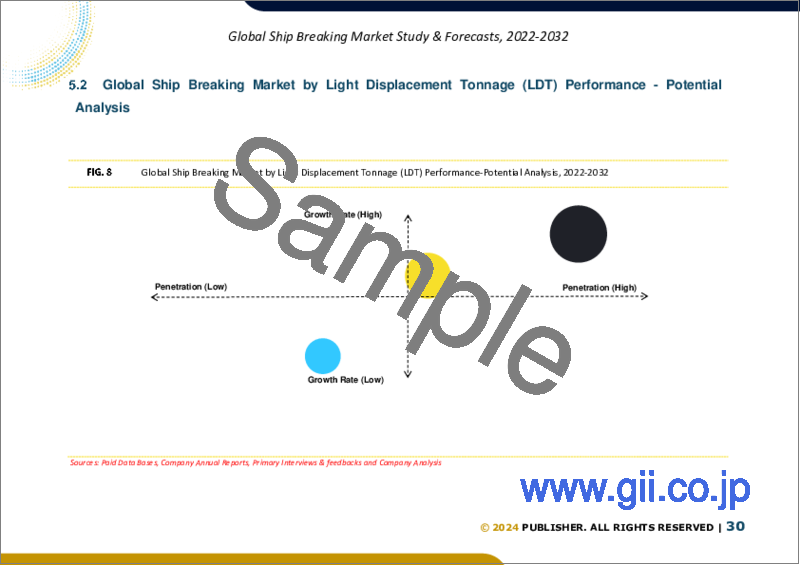|
|
市場調査レポート
商品コード
1543745
船舶解体の世界市場規模調査:軽排気トン数(LDT)別、方法別、船舶タイプ別、地域別予測:2022-2032年Global Ship Breaking Market Size Study, by Light Displacement Tonnage, by Method, by Type of Ship, and Regional Forecasts 2022-2032 |
||||||
カスタマイズ可能
|
|||||||
| 船舶解体の世界市場規模調査:軽排気トン数(LDT)別、方法別、船舶タイプ別、地域別予測:2022-2032年 |
|
出版日: 2024年08月25日
発行: Bizwit Research & Consulting LLP
ページ情報: 英文 285 Pages
納期: 2~3営業日
|
- 全表示
- 概要
- 目次
船舶解体の世界市場は、2023年に約39億8,000万米ドルと評価され、予測期間2024年から2032年にかけて8.2%以上の健全な成長率で成長すると予測されています。
船舶解体は、寿命が尽きると予想される船舶の解体を指します。船舶は稼働率や状態に応じて、ヤードにスクラップとして送られ、ヤードは船舶の軽排気量トン数(LDT)に基づいて、船舶所有者に解体やスクラップの費用を請求します。シップリサイクルヤードの大半は南アジア、特に中国、インド、バングラデシュ、パキスタンに存在します。
この市場は、船舶の老朽化、排出規制、安全対策など様々な要因によって成長を遂げています。船の種類、年間利用率、船の状態、その他の要因によって異なるが、平均して船は25年から40年でリサイクルに回されます。船舶の老朽化は船舶解体市場の大きな促進要因であり、世界中の多くの船舶がその運用寿命を迎えています。国連貿易開発会議(UNCTAD)によると、世界の商業船隊の平均年齢は約21年です。老朽化した船舶はしばしば効率が低下し、維持コストが高くなるため、船舶所有者は退役やリサイクルの選択肢を検討するようになります。2021年現在、世界の船隊の約25%が20年以上経過しており、相当数の船舶がライフサイクルの終わりに近づいていることを示しています。この動向は、特に船舶リサイクルの大半が行われている南アジアなどの地域において、船舶解体サービスに対する需要の増加をもたらしています。船舶解体産業は、鋼鉄のような貴重な材料を再利用し、老朽化した船舶に関連する環境リスクを軽減するために不可欠です。さらに、新しい船舶リサイクルヤードの開発、自動化、ロボット化は、予測される年月の間に様々な有利な機会を提示します。しかし、安全性と環境規制、経済性は、2024年から2032年の予測期間を通じて、市場の成長に課題となっています。
世界の船舶解体市場の調査で考慮した主要地域は、アジア太平洋、北米、欧州、中南米、その他ラテンアメリカです。北米は、収益の面で世界の船舶解体市場の支配的な地域です。同地域の市場成長は、欧州事業者の船舶所有が集中していることなどが要因となっています。一方、アジア太平洋地域の市場は、中国、韓国、日本などの主要な船舶所有者に後押しされ、予測期間中に最も速い速度で成長すると予想されています。同地域の廃船ヤードの広範なネットワークがこの成長を支えており、多くの造船所が需要増に対応し経済発展を促進するため、年間の廃船能力を拡大しています。
目次
第1章 世界の船舶解体市場エグゼクティブサマリー
- 船舶解体の世界市場規模・予測(2022-2032年)
- 地域別概要
- セグメント別概要
- 軽排気量トン数(LDT)別
- 方法別
- 船舶タイプ別
- 主要動向
- 景気後退の影響
- アナリストの結論・提言
第2章 世界の船舶解体市場の定義と調査前提条件
- 調査目的
- 市場の定義
- 調査前提条件
- 包含と除外
- 制限事項
- 供給サイドの分析
- 入手可能性
- インフラ
- 規制環境
- 市場競争
- 経済性(消費者の視点)
- 需要サイド分析
- 規制の枠組み
- 技術の進歩
- 環境への配慮
- 消費者の意識と受容
- 調査手法
- 調査対象年
- 通貨換算レート
第3章 世界の船舶破壊市場力学
- 市場促進要因
- 船舶の老朽化
- 海洋排出規制
- 市場の課題
- 安全・環境規制
- 経済性
- 市場機会
- 新しいシップリサイクルヤードの開発
- 自動化とロボット工学
第4章 世界の船舶解体市場産業分析
- ポーターのファイブフォースモデル
- 供給企業の交渉力
- 買い手の交渉力
- 新規参入業者の脅威
- 代替品の脅威
- 競争企業間の敵対関係
- ポーターのファイブフォースモデルへの未来的アプローチ
- ポーターのファイブフォースの影響分析
- PESTEL分析
- 政治
- 経済
- 社会
- 技術
- 環境
- 法律
- 主な投資機会
- 主要成功戦略
- 破壊的動向
- 業界専門家の視点
- アナリストの結論・提言
第5章 船舶解体の世界市場規模・予測:軽排気トン数(LDT)別、2022-2032年
- セグメントダッシュボード
- 世界の船舶解体市場:収益動向分析、2022年・2032年
- 20,000トン未満
- 20,000トン以上40,000トン未満
- 40,000トン以上
第6章 船舶解体の世界市場規模・予測:方法別、2022-2032年
- セグメントダッシュボード
- 世界の船舶解体市場:収益動向分析、2022年・2032年
- 横付け
- ビーチング
- ドライドック
- その他
第7章 船舶解体の世界市場規模・予測:船舶タイプ別、2022-2032年
- セグメントダッシュボード
- 世界の船舶解体市場:収益動向分析、2022年・2032年
- タンカー
- バルクキャリア
- フェリー・旅客船
- コンテナ船
- 一般貨物船
- その他
第8章 世界の船舶解体市場規模・予測:地域別、2022-2032年
- 北米
- 米国
- カナダ
- 欧州
- 英国
- ドイツ
- フランス
- スペイン
- イタリア
- その他欧州
- アジア太平洋
- 中国
- インド
- 日本
- オーストラリア
- 韓国
- その他アジア太平洋地域
- ラテンアメリカ
- ブラジル
- メキシコ
- その他ラテンアメリカ
- 中東・アフリカ
- サウジアラビア
- 南アフリカ
- その他中東とアフリカ
第9章 競合情報
- 主要企業のSWOT分析
- 主要市場戦略
- 企業プロファイル
- Habib Group(Bangladesh)
- 主要情報
- 概要
- 財務(データの入手可能性によります)
- 製品概要
- 市場戦略
- Ratanpur Ship Recycling Industries(Bangladesh)
- Chittagong Ship Yard(Bangladesh)
- Arefin Enterprise(Bangladesh)
- Changjiang(China)
- Zhoushan(China)
- PHP Ship Breaking and Recycling Industries(Bangladesh)
- Alang Ship Yard(India)
- iZMiR Ship Recycling(Turkey)
- Spot Shipping AS(Turkey)
- Zhengyuan Shipping Pte Ltd
- Best Oasis Limited
- Indigo Marine Services LLP
- Avinash Ship Breaking Industries Pvt. Ltd.
- S.R. Shipping Limited
- Habib Group(Bangladesh)
第10章 調査プロセス
- 調査プロセス
- データマイニング
- 分析
- 市場推定
- 検証
- 出版
- 調査属性
Global Ship Breaking Market is valued at approximately USD 3.98 billion in 2023 and is anticipated to grow with a healthy growth rate of more than 8.2% over the forecast period 2024-2032. Ship breaking refers to the dismantling of a ship after its estimated end of life. Based on utilization and condition, vessels are sent for scrapping to yards, which charge ship owners based on the Light Displacement Tonnage (LDT) of a ship for end-to-end dismantling or scrapping. The majority of ship recycling yards are present across South Asia, particularly in China, India, Bangladesh, and Pakistan.
The market is experiencing growth driven by various factors, such as the aging fleet, emission regulations, and safety measures. On average, ships are sent to recycling at the age of 25 to 40 years depending on the type of ship, annual utilization, vessel condition, and other factors. The aging ship fleet is a significant driver in the ship-breaking market, as many vessels worldwide are reaching the end of their operational life. According to the United Nations Conference on Trade and Development (UNCTAD), the average age of the global commercial fleet is around 21 years . Older ships often become less efficient and more costly to maintain, leading ship owners to consider decommissioning and recycling options. As of 2021, about 25% of the global fleet was over 20 years old , indicating a substantial number of ships are nearing the end of their lifecycle. This trend has resulted in increased demand for ship-breaking services, particularly in regions such as South Asia, where the majority of ship recycling takes place . The ship-breaking industry is essential for repurposing valuable materials like steel and reducing environmental risks associated with outdated vessels. Moreover, the development of new ship recycling yards, as well as automation and robotics present various lucrative opportunities over the forecast years. However, the safety and environmental regulations, as well as economic viability are challenging the market growth throughout the forecast period of 2024-2032.
The key regions considered for the Global Ship Breaking Market study include Asia Pacific, North America, Europe, Latin America, and Rest of the World. North America is a dominating region in the Global Ship Breaking Market in terms of revenue. The market growth in the region is being attributed to factors including its high concentration of ship ownership among European operators. Whereas, the market in Asia Pacific is anticipated to grow at the fastest rate over the forecast period fueled by major ship owners in countries such as China, South Korea, and Japan. The region's extensive network of ship scrapping yards supports this growth, with many shipyards expanding their annual ship-breaking capacity to meet increasing demand and drive economic development.
Major market players included in this report are:
- Habib Group (Bangladesh)
- Ratanpur Ship Recycling Industries (Bangladesh)
- Chittagong Ship Yard (Bangladesh)
- Arefin Enterprise (Bangladesh)
- Changjiang (China)
- Zhoushan (China)
- PHP Ship Breaking and Recycling Industries (Bangladesh)
- Alang Ship Yard (India)
- iZMiR Ship Recycling (Turkey)
- Spot Shipping AS (Turkey)
- Zhengyuan Shipping Pte Ltd
- Best Oasis Limited
- Indigo Marine Services LLP
- Avinash Ship Breaking Industries Pvt. Ltd.
- S.R. Shipping Limited
The detailed segments and sub-segment of the market are explained below:
By Light Displacement Tonnage (LDT):
- Below 20,000 Tons
- 20,000 to 40,000 Tons
- Above 40,000 Tons
By Method:
- Alongside
- Beaching
- Dry Dock
- Other
By Type of Ship:
- Tankers
- Bulk Carriers
- Ferries and Passenger Ships
- Container Ship
- General Cargo Ship
- Others
By Region:
- North America
- U.S.
- Canada
- Europe
- UK
- Germany
- France
- Spain
- Italy
- ROE
- Asia Pacific
- China
- India
- Japan
- Australia
- South Korea
- RoAPAC
- Latin America
- Brazil
- Mexico
- Rest of Latin America
- Middle East & Africa
- Saudi Arabia
- South Africa
- RoMEA
Years considered for the study are as follows:
- Historical year - 2022
- Base year - 2023
- Forecast period - 2024 to 2032
Key Takeaways:
- Market Estimates & Forecast for 10 years from 2022 to 2032.
- Annualized revenues and regional level analysis for each market segment.
- Detailed analysis of geographical landscape with Country level analysis of major regions.
- Competitive landscape with information on major players in the market.
- Analysis of key business strategies and recommendations on future market approach.
- Analysis of competitive structure of the market.
- Demand side and supply side analysis of the market.
Table of Contents
Chapter 1. Global Ship Breaking Market Executive Summary
- 1.1. Global Ship Breaking Market Size & Forecast (2022-2032)
- 1.2. Regional Summary
- 1.3. Segmental Summary
- 1.3.1. By Light Displacement Tonnage (LDT)
- 1.3.2. By Method
- 1.3.3. By Type of Ship
- 1.4. Key Trends
- 1.5. Recession Impact
- 1.6. Analyst Recommendation & Conclusion
Chapter 2. Global Ship Breaking Market Definition and Research Assumptions
- 2.1. Research Objective
- 2.2. Market Definition
- 2.3. Research Assumptions
- 2.3.1. Inclusion & Exclusion
- 2.3.2. Limitations
- 2.3.3. Supply Side Analysis
- 2.3.3.1. Availability
- 2.3.3.2. Infrastructure
- 2.3.3.3. Regulatory Environment
- 2.3.3.4. Market Competition
- 2.3.3.5. Economic Viability (Consumer's Perspective)
- 2.3.4. Demand Side Analysis
- 2.3.4.1. Regulatory frameworks
- 2.3.4.2. Technological Advancements
- 2.3.4.3. Environmental Considerations
- 2.3.4.4. Consumer Awareness & Acceptance
- 2.4. Estimation Methodology
- 2.5. Years Considered for the Study
- 2.6. Currency Conversion Rates
Chapter 3. Global Ship Breaking Market Dynamics
- 3.1. Market Drivers
- 3.1.1. Aging Ship Fleet
- 3.1.2. Marine Emission Regulations
- 3.2. Market Challenges
- 3.2.1. Safety and Environmental Regulations
- 3.2.2. Economic Viability
- 3.3. Market Opportunities
- 3.3.1. Development of New Ship Recycling Yards
- 3.3.2. Automation and Robotics
Chapter 4. Global Ship Breaking Market Industry Analysis
- 4.1. Porter's 5 Force Model
- 4.1.1. Bargaining Power of Suppliers
- 4.1.2. Bargaining Power of Buyers
- 4.1.3. Threat of New Entrants
- 4.1.4. Threat of Substitutes
- 4.1.5. Competitive Rivalry
- 4.1.6. Futuristic Approach to Porter's 5 Force Model
- 4.1.7. Porter's 5 Force Impact Analysis
- 4.2. PESTEL Analysis
- 4.2.1. Political
- 4.2.2. Economical
- 4.2.3. Social
- 4.2.4. Technological
- 4.2.5. Environmental
- 4.2.6. Legal
- 4.3. Top investment opportunity
- 4.4. Top winning strategies
- 4.5. Disruptive Trends
- 4.6. Industry Expert Perspective
- 4.7. Analyst Recommendation & Conclusion
Chapter 5. Global Ship Breaking Market Size & Forecasts by Light Displacement Tonnage (LDT) 2022-2032
- 5.1. Segment Dashboard
- 5.2. Global Ship Breaking Market: Light Displacement Tonnage (LDT) Revenue Trend Analysis, 2022 & 2032 (USD Billion)
- 5.2.1. Below 20,000 Tons
- 5.2.2. 20,000 to 40,000 Tons
- 5.2.3. Above 40,000 Tons
Chapter 6. Global Ship Breaking Market Size & Forecasts by Method 2022-2032
- 6.1. Segment Dashboard
- 6.2. Global Ship Breaking Market: Method Revenue Trend Analysis, 2022 & 2032 (USD Billion)
- 6.2.1. Alongside
- 6.2.2. Beaching
- 6.2.3. Dry Dock
- 6.2.4. Other
Chapter 7. Global Ship Breaking Market Size & Forecasts by Type of Ship 2022-2032
- 7.1. Segment Dashboard
- 7.2. Global Ship Breaking Market: Type of Ship Revenue Trend Analysis, 2022 & 2032 (USD Billion)
- 7.2.1. Tankers
- 7.2.2. Bulk Carriers
- 7.2.3. Ferries and Passenger Ships
- 7.2.4. Container Ship
- 7.2.5. General Cargo Ship
- 7.2.6. Others
Chapter 8. Global Ship Breaking Market Size & Forecasts by Region 2022-2032
- 8.1. North America Ship Breaking Market
- 8.1.1. U.S. Ship Breaking Market
- 8.1.1.1. Light Displacement Tonnage (LDT) breakdown size & forecasts, 2022-2032
- 8.1.1.2. Method breakdown size & forecasts, 2022-2032
- 8.1.1.3. Type of Ship breakdown size & forecasts, 2022-2032
- 8.1.2. Canada Ship Breaking Market
- 8.1.1. U.S. Ship Breaking Market
- 8.2. Europe Ship Breaking Market
- 8.2.1. UK Ship Breaking Market
- 8.2.2. Germany Ship Breaking Market
- 8.2.3. France Ship Breaking Market
- 8.2.4. Spain Ship Breaking Market
- 8.2.5. Italy Ship Breaking Market
- 8.2.6. Rest of Europe Ship Breaking Market
- 8.3. Asia-Pacific Ship Breaking Market
- 8.3.1. China Ship Breaking Market
- 8.3.2. India Ship Breaking Market
- 8.3.3. Japan Ship Breaking Market
- 8.3.4. Australia Ship Breaking Market
- 8.3.5. South Korea Ship Breaking Market
- 8.3.6. Rest of Asia Pacific Ship Breaking Market
- 8.4. Latin America Ship Breaking Market
- 8.4.1. Brazil Ship Breaking Market
- 8.4.2. Mexico Ship Breaking Market
- 8.4.3. Rest of Latin America Ship Breaking Market
- 8.5. Middle East & Africa Ship Breaking Market
- 8.5.1. Saudi Arabia Ship Breaking Market
- 8.5.2. South Africa Ship Breaking Market
- 8.5.3. Rest of Middle East & Africa Ship Breaking Market
Chapter 9. Competitive Intelligence
- 9.1. Key Company SWOT Analysis
- 9.2. Top Market Strategies
- 9.3. Company Profiles
- 9.3.1. Habib Group (Bangladesh)
- 9.3.1.1. Key Information
- 9.3.1.2. Overview
- 9.3.1.3. Financial (Subject to Data Availability)
- 9.3.1.4. Product Summary
- 9.3.1.5. Market Strategies
- 9.3.2. Ratanpur Ship Recycling Industries (Bangladesh)
- 9.3.3. Chittagong Ship Yard (Bangladesh)
- 9.3.4. Arefin Enterprise (Bangladesh)
- 9.3.5. Changjiang (China)
- 9.3.6. Zhoushan (China)
- 9.3.7. PHP Ship Breaking and Recycling Industries (Bangladesh)
- 9.3.8. Alang Ship Yard (India)
- 9.3.9. iZMiR Ship Recycling (Turkey)
- 9.3.10. Spot Shipping AS (Turkey)
- 9.3.11. Zhengyuan Shipping Pte Ltd
- 9.3.12. Best Oasis Limited
- 9.3.13. Indigo Marine Services LLP
- 9.3.14. Avinash Ship Breaking Industries Pvt. Ltd.
- 9.3.15. S.R. Shipping Limited
- 9.3.1. Habib Group (Bangladesh)
Chapter 10. Research Process
- 10.1. Research Process
- 10.1.1. Data Mining
- 10.1.2. Analysis
- 10.1.3. Market Estimation
- 10.1.4. Validation
- 10.1.5. Publishing
- 10.2. Research Attributes






